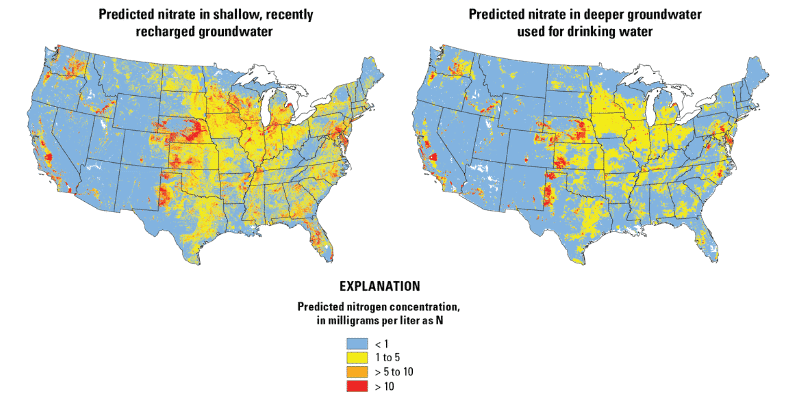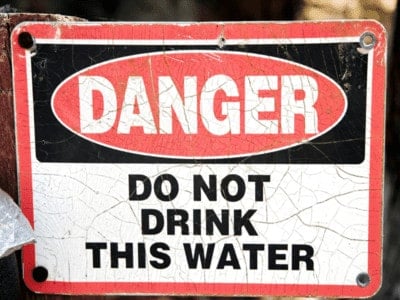
Nitrates are naturally occurring nitrogen-based compounds that plants and people need to survive. But like oxygen and sunshine, too much of them in the wrong place — like your drinking water — spells trouble.
Let’s take a closer look at nitrates, a common well water contaminant that young families should know about. We’ll show you how to test for nitrates in water, reduce your exposure and protect your health.
What Are Nitrates?
Nitrate is formed when nitrogen and oxygen or ozone combine. Present in most soil but in low levels that don’t pose a health risk, it comes in several forms.
Nitrate Vs Nitrites?
Nitrates and nitrites are similar. They vary only in the number of oxygen molecules they contain. The term “nitrate nitrogen” refers to the nitrogen atom within a nitrate molecule. It’s used only to help differentiate among the different forms of nitrates and nitrites used for industrial purposes.
How Do Nitrates Get into Groundwater?

Excess nitrates come from both natural and synthetic sources. They’re used in manufacturing, agriculture, glass production, food preservation and more. Easily dissolved, they readily flow from the soil into groundwater and surface water sources as the rain falls and snow melts.
Most nitrate contamination comes from:
#1 Fertilizers
Nitrates and nitrites are ubiquitous in agriculture. Used as pesticides and fertilizers by farms, animal feedlots, golf courses and more, runoff from these areas can contaminate private wells.
#2 Industrial Waste
Nitrates and nitrites are used by munitions factories, food processing plants, the pharmaceutical industry and more. Untreated waste from any of these manufacturing sites in your watershed can seep into the soil and migrate into shallow wells.
#3 Human and Animal Waste
Human and animal wastes are packed with bacteria and nitrates, so contamination can occur when they’re not properly contained. Broken or poorly placed septic systems and shoddy well construction can all result in waste leaching into your well water. Feedlots are among the biggest culprits where large volumes of animal waste can be swept into the surrounding groundwater.
#4 Flooding
Even if your watershed is free of manufacturing and agricultural centers, floodwaters can carry nitrates and nitrites from miles away. If you live in a flood plain and drink from a shallow well, beware.
What Are Safe Nitrate Concentrations?
A low concentration of nitrate — 1-2 mg/L is found in most water. So, at what point do elevated levels become nitrate contamination? The Environmental Protection Agency (EPA) sets the recommended limits for both synthetic and naturally occurring contaminants. For nitrite, the level is 1 mg/L. Levels of nitrate above 10 mg/L are considered hazardous.
What Are the Health Risks of Nitrate and Nitrite?
High concentrations of nitrate in drinking water are associated with a wide range of health problems.
In adults, the health effects may include:
- Thyroid disorders
- Recurrent respiratory infections
- Cancer of the stomach or bladder
Infants under six months old and pregnant women, however, are at the highest risk for health effects, including miscarriages, blood disorders and neural tube defects in fetuses. In newborns, they cause a blood oxygen defect known as “blue baby syndrome.”
For this reason, the Centers for Disease Control and Prevention (CDC) recommend testing well water at least annually for pH, nitrate and bacteria and on a more regular basis if there are infants in the home. Use only bottled or filtered water if levels are above 10 mg/L.
How Can Tell if There Are Nitrates and Nitrites in My Drinking Water Supply?
If you drink from a public water system, treatment officials and the environmental health division of your local health department are well aware of the nitrate sources present in your watershed. Your annual water quality report notes the levels of nitrate as well other problem contaminants in your drinking water supply. With rare exceptions, nitrate levels are carefully controlled.
If you have a private well, testing is your responsibility. No agency monitors or regulates nitrate levels in well water, but if you live where nitrate contamination from fertilizer or other sources is likely, you’re at greater risk.
Unlike other contaminants, nitrate and nitrite have no taste, color or odor. The only way to know if they’re in your well is to have the water tested. The good news is that doing water tests has never been simpler.
Testing Your Water for Nitrates and Nitrites

Testing your drinking water source is straightforward and economical. You can send a water sample to a lab or choose from several DIY test kits. For nitrate testing, we recommend using an accredited laboratory. They use only the most advanced techniques to ensure accurate test results.
We like SimpleLab’s Tap Score because it’s flexible, affordable and a breeze to use. Everything you need is in the kit, including sample containers, easy-to-understand instructions and a prepaid return label.
Collect water samples as directed and return them in the box provided. Choose nitrate testing alone or select from panels that cover other common contaminants in a private well. Bacteria, for example, occur naturally where there are high levels of nitrate from animal waste while other chemical fertilizers may be a problem if you live near farms.
You’ll get test results in two weeks that include objective recommendations for water treatment systems if your nitrate levels are above 10 mg/L. They don’t sell filters, so it’s like having a friend in your corner.
If you have high levels of nitrate and opt to install a treatment system, the EPA recommends retesting your drinking water every six months until the concentration declines. DIY water testing is a cost-effective way to monitor its performance between lab tests. Test strips are less than $20 a bottle and will verify your filter is working. How’s that for peace of mind?
How to Protect Your Drinking Water with a Filtration System
Whether you have nitrates in your drinking water now or want to mitigate future risks, these treatment options remove nitrate and nitrite from water.
#1 Reverse Osmosis (RO)
Reverse osmosis filters remove high levels of most contaminants plus up to 92-percent of nitrates by forcing them through a membrane with microscopic pores. If a water test shows nitrate and bacteria, RO filters are among the few treatment systems capable of removing both.
#3 Ion Exchange
Conventional salt-based water softeners remove neither nitrate nor nitrite. But similar chloride-based nitrate treatment systems do.
#4 Distillation
Boiling water concentrates nitrates. But distillation eliminates most substances, including nitrate and nitrite, by boiling water and capturing condensed steam. Distilled drinking water is virtually pure.
Choosing the Best Water Treatment System
If testing shows you need a treatment system, you have choices to make. Let’s look at the criteria you should consider when selecting a water filter.
#1 Contaminants
Getting rid of drinking water nitrates is a priority, but what if testing showed other dangerous substances such as bacteria, chemicals or lead? Choosing a single filtration method that tackles all contaminants your test revealed is ideal.
#2 Capacity
Two types of filters remove nitrate and nitrite — whole-house, or point-of-entry systems, that are plumbed into your water supply line and treat water throughout your home, and point-of-use systems, like countertop and undersink filters that purify drinking and cooking water from the kitchen faucet.
For removing chemicals, like chlorine, that make showering miserable, whole-home filters that provide large volumes of clean water home-wide are preferable. But nitrates aren’t absorbed through the skin, so point-of-entry filters are also good choices despite their limited capacity.
#3 Nitrate Levels
If testing shows a high concentration of nitrates, you need a filter with an equally high reduction percentage to reduce it to safe levels. Consider your risks. If you have kids in the house, is reducing nitrates from 20 mg/L to 10 mg/L good enough, or is reducing it to 5 mg/L better for their health? Aim for low concentrations.
#4 Price
Whole-house filtration systems can cost thousands. They’re a good value, but if a test shows nitrates, and you’re on a budget, less expensive RO filters and home distillers can be equally effective. Safety should be your top priority.
#5 Installation
Whole-home filters require permanent changes to plumbing that add to the installation fee. And what if you rent? Even if testing shows nitrates, will your landlord agree to have a filtration system installed? Apartment-friendly, distillers and RO systems can be used anywhere.
Final Thoughts
Safeguarding your family’s health against nitrates begins with testing a water sample. Only with knowledge comes the power to take action.
 85 people found this helpful. Was this guide helpful to you?
85 people found this helpful. Was this guide helpful to you? 

